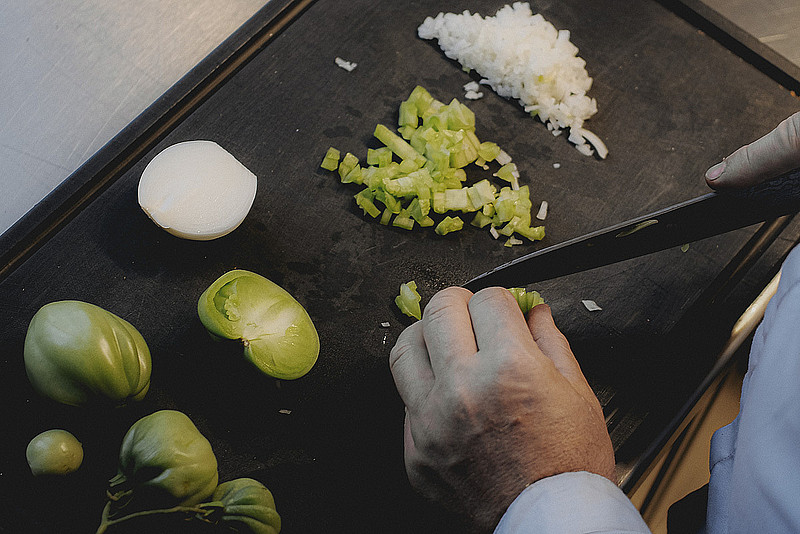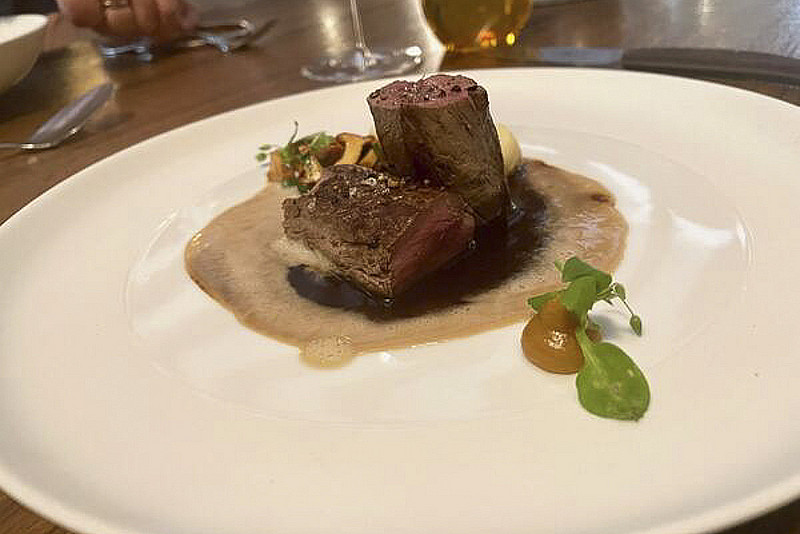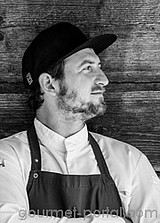Recipe
Fermenting, drying & pickling
PRIEN AM CHIEMSEE. The term sustainability is on everyone's lips. In times of resource scarcity, there is a growing social awareness of the need to treat what Mother Nature gives us with care. Sustainability also means a conscious approach to food. Instead of carelessly disposing of unripe food and leftovers, they are preserved so that they can be served at a later date with enhanced flavour. Fruit, vegetables, herbs and mushrooms are fermented, dried and pickled. Preserving like in grandma's day! This trend has long since reached high-end gastronomy. For Michelin-starred chef Dominik Wachter from Prien am Chiemsee, this trend manifests itself in the way he treats his guests and, of course
and, of course, by treating his locally sourced food with respect, which he prepares in Wachter's food bar in harmony with the seasons. However, if there is anything left over, he preserves it. The star chef from Prien am Chiemsee reveals how Wachter does this in an interview. Interesting facts and tips about fermenting, drying and preserving.
What are the differences between fermenting, drying and pickling food?
Wachter: "Drying and pickling are all about flavour, consistency and preservation. The main difference in fermentation is the lactic acid bacteria. During fermentation, food is usually modified with at least 2% salt for several days to weeks, sometimes even months, by the resulting lactic acid bacteria, yeasts or enzymes. Whether this happens in a brine or in its own liquid is of secondary importance. Fermentation brings the product to life and not only gives it a different and more complex flavour, but also enriches it with valuable bacteria."
The product is available on German shelves for almost 12 months. Why is it still worth looking into preserving products?
Wachter: "Nowadays, of course, the daily supply is independent of season and origin. However, not all the food I use in my kitchen is available to buy. I like to use products from nature, which I collect myself with my team and then process. It is also important to me to process the products according to what is in season - and mainly from local producers. We therefore use tried and tested techniques to preserve certain products and refine them at another time.
What innovative techniques or methods do you use to refine the flavours and textures of fermented foods?
Wachter: "The creative possibilities are limitless in the world of fermentation. First and foremost, it's all about flavour, which can be influenced by different fermented foods. To achieve a more complex density of flavours, I use fermented pastes, vegetable juices, grains and the like. Techniques such as dehydration, hydrogenation and reduction create a new flavour profile of the aromas."
How do you take seasonal availability and regional ingredients into account when planning and preparing fermented dishes?
Wachter: Nature dictates the availability. For example, I can't influence whether elderberries or woodruff ripen earlier or later in a given year. It's the same with other products. I also get advice from my local suppliers on what they consider to be of the best quality at any given time."
What are your favourite fermented, dried or pickled foods?
Wachter: "I'm very flexible here, as every fermentation always brings new surprises and flavours. However, I am a big fan of Asian flavours, which I associate with home cooking. Miso pastes, shoyu and garum are therefore very interesting, but unfortunately I can't make them all myself due to lack of space. Dried and powdered mushroom sponges or roasted beechnuts and nettle seeds are also among my favourite products. Probably my greatest love in fermentation is my sourdough lady "Eleonore"."
Hand on heart: must have or nice to have? What role do fermenting, pickling and drying food play in your kitchen?
Wachter: "Definitely a big role, as each of my menus includes various products that have been processed in one of these three ways. The sourdough bread alone is highly valued by my guests and should not be missing from any menu. But there's always something of my treasures hidden in the other dishes too, which add that little bit extra and bring the home of Prien am Chiemsee to the plate."
Do you have any tips for when the last tomatoes are no longer ripe in autumn?
Wachter: "Yes, of course! I usually make a fermented tomato salsa from the last green tomatoes in my garden. Here is the recipe. Enjoy it!"
Recipe: fermented green tomato salsa
- Ingredients for a 0.5 litre preserving jar:
- 500g green unripe tomatoes from the garden
- a 60g white onion
- 10g good olive oil
- 2g sugar
- 3-5 turns of the pepper mill
- Fresh garden herbs
- 2 sprigs of thyme, just the fine leaves
- 2 sprigs of parsley with stalk
- 2 sprigs of coriander (if you like), with stalk
- 5 basil leaves
- 2% uniodised salt to the total amount
Preparation: Sterilise the preserving jar in boiling water or with steam. Wash the tomatoes, remove the stalk and cut into cubes. Finely dice the onion and mix with the tomatoes. Finely chop the fresh herbs and mix with the diced tomatoes and the remaining ingredients and weigh out. Then add the 2% salt (to the total amount) and knead carefully with gloves or clean hands to release the liquid. Pour the salsa into the preserving jar and weigh it down with a weight so that all the ingredients are covered with the liquid.
Tip: A cabbage leaf, blackcurrant leaf or cling film is ideal for weighing down the salsa. The advantage of the leaves is the tannins they contain, which help to preserve the structure of the ferment. Then remove the seal from the lid of the jar so that the resulting gases can escape. Leave the green tomato salsa to stand at room temperature for 3 to 5 days (the longer, the more acid is produced by the lactic acid bacteria) and then close tightly with the seal and store in a cool place. The salsa will keep for several weeks in the fridge, but you should always help yourself to it with a clean spoon.
Food recommendation: The fermented green tomato salsa goes perfectly with grilled meat or fish, cheese, e.g. goat's cheese, and baked vegetables such as pumpkin.





